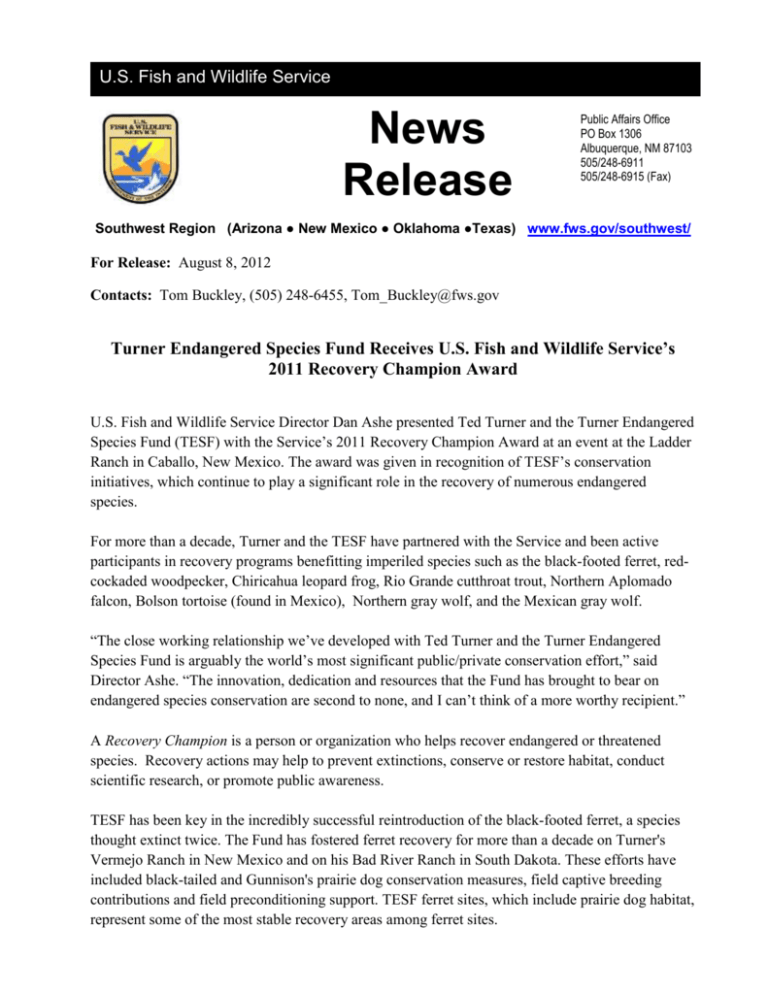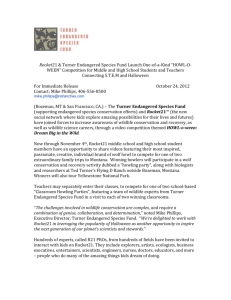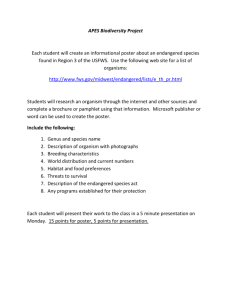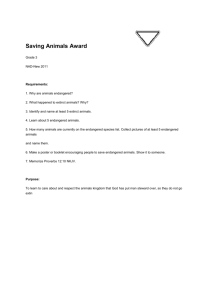Turner Recovery Champion Award event OCO 8-3-12
advertisement

U.S. Fish and Wildlife Service News Release Public Affairs Office PO Box 1306 Albuquerque, NM 87103 505/248-6911 505/248-6915 (Fax) Southwest Region (Arizona ● New Mexico ● Oklahoma ●Texas) www.fws.gov/southwest/ For Release: August 8, 2012 Contacts: Tom Buckley, (505) 248-6455, Tom_Buckley@fws.gov Turner Endangered Species Fund Receives U.S. Fish and Wildlife Service’s 2011 Recovery Champion Award U.S. Fish and Wildlife Service Director Dan Ashe presented Ted Turner and the Turner Endangered Species Fund (TESF) with the Service’s 2011 Recovery Champion Award at an event at the Ladder Ranch in Caballo, New Mexico. The award was given in recognition of TESF’s conservation initiatives, which continue to play a significant role in the recovery of numerous endangered species. For more than a decade, Turner and the TESF have partnered with the Service and been active participants in recovery programs benefitting imperiled species such as the black-footed ferret, redcockaded woodpecker, Chiricahua leopard frog, Rio Grande cutthroat trout, Northern Aplomado falcon, Bolson tortoise (found in Mexico), Northern gray wolf, and the Mexican gray wolf. “The close working relationship we’ve developed with Ted Turner and the Turner Endangered Species Fund is arguably the world’s most significant public/private conservation effort,” said Director Ashe. “The innovation, dedication and resources that the Fund has brought to bear on endangered species conservation are second to none, and I can’t think of a more worthy recipient.” A Recovery Champion is a person or organization who helps recover endangered or threatened species. Recovery actions may help to prevent extinctions, conserve or restore habitat, conduct scientific research, or promote public awareness. TESF has been key in the incredibly successful reintroduction of the black-footed ferret, a species thought extinct twice. The Fund has fostered ferret recovery for more than a decade on Turner's Vermejo Ranch in New Mexico and on his Bad River Ranch in South Dakota. These efforts have included black-tailed and Gunnison's prairie dog conservation measures, field captive breeding contributions and field preconditioning support. TESF ferret sites, which include prairie dog habitat, represent some of the most stable recovery areas among ferret sites. The Ladder Ranch Wolf Management Facility is one of only three primary captive pre-release facilities in the U.S. Since 1997 the facility has been instrumental in housing and selectively breeding Mexican wolves, one of the rarest land mammals in the Northern Hemisphere, for release to the wild. In addition, the Seco Creek drainage on the Ladder Ranch is home to the last large population of endangered Chiricahua leopard frogs in New Mexico. The facility’s efforts to protect and restore habitat for Chiricahua leopard frogs are crucial to the Frog’s recovery. In the Southeast, TESF is working to preserve the red-cockaded woodpecker, one of only two woodpecker species protected by the Endangered Species Act. Habitat restoration work began at TESF’s Avalon Plantation in Florida in 1998, involving other private landowners and providing a model for public-private conservation partnerships. “The Turner Endangered Species Fund continues to build on its successes and make a difference for dozens of species facing extinction,” said Benjamin Tuggle, the Service’s Southwest Regional Director. “The Fund continues to think outside the box and demonstrate what’s possible, setting a high bar of accomplishment for other collaborative conservation efforts throughout the country.” The mission of the U.S. Fish and Wildlife Service is working with others to conserve, protect, and enhance fish, wildlife, plants, and their habitats for the continuing benefit of the American people. We are both a leader and trusted partner in fish and wildlife conservation, known for our scientific excellence, stewardship of lands and natural resources, dedicated professionals, and commitment to public service. For more information on our work and the people who make it happen, visit www.fws.gov. Connect with our Facebook page at www.facebook.com/usfws, follow our tweets at www.twitter.com/usfwshq, watch our YouTube Channel at http://www.youtube.com/usfws and download photos from our Flickr page at http://www.flickr.com/photos/usfwshq. http://www.fws.gov/southwest









